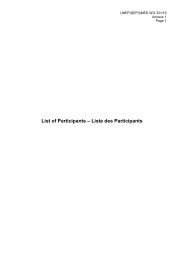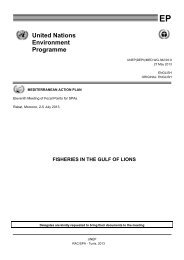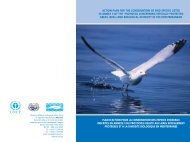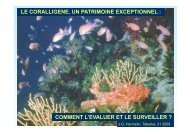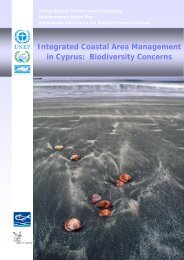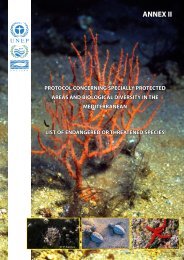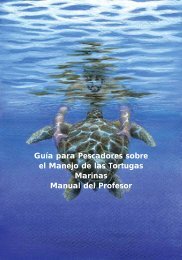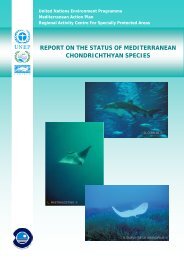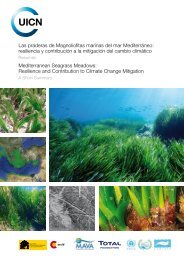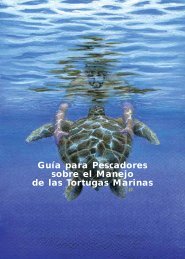Proceedings of the Second Mediterranean Symposium on Marine
Proceedings of the Second Mediterranean Symposium on Marine
Proceedings of the Second Mediterranean Symposium on Marine
You also want an ePaper? Increase the reach of your titles
YUMPU automatically turns print PDFs into web optimized ePapers that Google loves.
PROCEEDINGS OF THE SECOND MEDITERRANEAN SYMPOSIUM ON MARINE VEGETATION (ATHENS, 12-13 DECEMBER 2003)<br />
40<br />
BIODIVERSITY<br />
Biological diversity (biodiversity) means <str<strong>on</strong>g>the</str<strong>on</strong>g> variety am<strong>on</strong>g living organisms from all<br />
sources including, inter alia, terrestrial, marine and o<str<strong>on</strong>g>the</str<strong>on</strong>g>r aquatic ecosystems and <str<strong>on</strong>g>the</str<strong>on</strong>g><br />
complexes <str<strong>on</strong>g>of</str<strong>on</strong>g> which <str<strong>on</strong>g>the</str<strong>on</strong>g>y are part. This includes diversity within species, diversity<br />
between species, between ecosystems, between landscapes and functi<strong>on</strong>al diversity<br />
(Ramade, 1994). Ecosystem diversity is <str<strong>on</strong>g>of</str<strong>on</strong>g>ten referred to as "ecodiversity".<br />
As far as species diversity is c<strong>on</strong>cerned, point species diversity refers to <str<strong>on</strong>g>the</str<strong>on</strong>g> number <str<strong>on</strong>g>of</str<strong>on</strong>g><br />
species within a sample, alpha species diversity to <str<strong>on</strong>g>the</str<strong>on</strong>g> number <str<strong>on</strong>g>of</str<strong>on</strong>g> species within a given<br />
habitat (e.g. <str<strong>on</strong>g>the</str<strong>on</strong>g> Posid<strong>on</strong>ia oceanica meadow) in a given regi<strong>on</strong> (e.g. Liguria), beta<br />
species diversity <str<strong>on</strong>g>the</str<strong>on</strong>g> species turnover between adjacent habitats <str<strong>on</strong>g>of</str<strong>on</strong>g> a given regi<strong>on</strong>,<br />
gamma species diversity to <str<strong>on</strong>g>the</str<strong>on</strong>g> number <str<strong>on</strong>g>of</str<strong>on</strong>g> species within all habitats <str<strong>on</strong>g>of</str<strong>on</strong>g> a given regi<strong>on</strong>,<br />
and epsil<strong>on</strong> species diversity <str<strong>on</strong>g>the</str<strong>on</strong>g> num-ber <str<strong>on</strong>g>of</str<strong>on</strong>g> species within a biogeographical province<br />
(e.g. <str<strong>on</strong>g>the</str<strong>on</strong>g> <str<strong>on</strong>g>Mediterranean</str<strong>on</strong>g> Sea) (Wils<strong>on</strong> and Shmida, 1984; Gray, 2000, 2001).<br />
Human impact may increase alpha diversity <str<strong>on</strong>g>of</str<strong>on</strong>g> low species diversity habitats or even <str<strong>on</strong>g>of</str<strong>on</strong>g><br />
some tax<strong>on</strong>omical groups in habitats with high species diversity (e.g. Dimech et al.,<br />
2002), while gamma diversity decreases. This is <str<strong>on</strong>g>the</str<strong>on</strong>g> reas<strong>on</strong> why some naïve authors<br />
emphasize that polluti<strong>on</strong> (e.g. aquaculture farms) and introduced species (e.g. Caulerpa<br />
taxifolia) c<strong>on</strong>stitute valuable diversity enhancers (Fig. 5).<br />
Fig. 5. Above: an example <str<strong>on</strong>g>of</str<strong>on</strong>g> alpha species diversity within 5 benthic habitats (A through E) in a given regi<strong>on</strong>.<br />
Gamma species diversity is not <str<strong>on</strong>g>the</str<strong>on</strong>g> sum <str<strong>on</strong>g>of</str<strong>on</strong>g> <str<strong>on</strong>g>the</str<strong>on</strong>g> 5 alpha diversities, since some species are comm<strong>on</strong> to <str<strong>on</strong>g>the</str<strong>on</strong>g><br />
five habitats (in black). Below: human impact (e.g. polluti<strong>on</strong> or <str<strong>on</strong>g>the</str<strong>on</strong>g> introduced species Caulerpa taxifolia) has<br />
more or less homogenized <str<strong>on</strong>g>the</str<strong>on</strong>g> communities (habitat F). The disturbance may increase (e.g. B, a sand bottom<br />
habitat) or decrease (e.g. E, a rocky bottom habitat) alpha species diversity. However, as far as gamma<br />
species diversity is c<strong>on</strong>cerned (right), it dramatically decreases.



